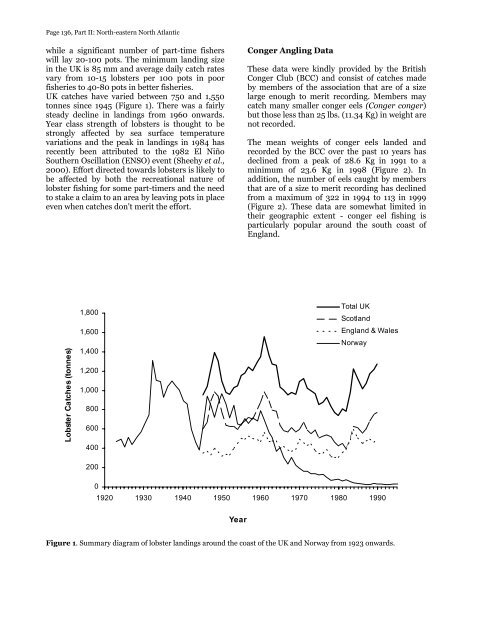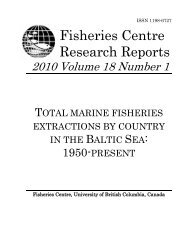Full text (PDF) - Sea Around Us Project
Full text (PDF) - Sea Around Us Project
Full text (PDF) - Sea Around Us Project
You also want an ePaper? Increase the reach of your titles
YUMPU automatically turns print PDFs into web optimized ePapers that Google loves.
Page 136, Part II: North-eastern North Atlantic<br />
while a significant number of part-time fishers<br />
will lay 20-100 pots. The minimum landing size<br />
in the UK is 85 mm and average daily catch rates<br />
vary from 10-15 lobsters per 100 pots in poor<br />
fisheries to 40-80 pots in better fisheries.<br />
UK catches have varied between 750 and 1,550<br />
tonnes since 1945 (Figure 1). There was a fairly<br />
steady decline in landings from 1960 onwards.<br />
Year class strength of lobsters is thought to be<br />
strongly affected by sea surface temperature<br />
variations and the peak in landings in 1984 has<br />
recently been attributed to the 1982 El Niño<br />
Southern Oscillation (ENSO) event (Sheehy et al.,<br />
2000). Effort directed towards lobsters is likely to<br />
be affected by both the recreational nature of<br />
lobster fishing for some part-timers and the need<br />
to stake a claim to an area by leaving pots in place<br />
even when catches don't merit the effort.<br />
Conger Angling Data<br />
These data were kindly provided by the British<br />
Conger Club (BCC) and consist of catches made<br />
by members of the association that are of a size<br />
large enough to merit recording. Members may<br />
catch many smaller conger eels (Conger conger)<br />
but those less than 25 lbs. (11.34 Kg) in weight are<br />
not recorded.<br />
The mean weights of conger eels landed and<br />
recorded by the BCC over the past 10 years has<br />
declined from a peak of 28.6 Kg in 1991 to a<br />
minimum of 23.6 Kg in 1998 (Figure 2). In<br />
addition, the number of eels caught by members<br />
that are of a size to merit recording has declined<br />
from a maximum of 322 in 1994 to 113 in 1999<br />
(Figure 2). These data are somewhat limited in<br />
their geographic extent - conger eel fishing is<br />
particularly popular around the south coast of<br />
England.<br />
Lobster Catches (tonnes)<br />
1,800<br />
1,600<br />
1,400<br />
1,200<br />
1,000<br />
800<br />
600<br />
400<br />
200<br />
Total UK<br />
Scotland<br />
England & Wales<br />
Norway<br />
0<br />
1920 1930 1940 1950 1960 1970 1980 1990<br />
Year<br />
Figure 1. Summary diagram of lobster landings around the coast of the UK and Norway from 1923 onwards.





![Nacion.com, San José, Costa Rica [Nacionales] - Sea Around Us ...](https://img.yumpu.com/26166123/1/190x245/nacioncom-san-josac-costa-rica-nacionales-sea-around-us-.jpg?quality=85)










